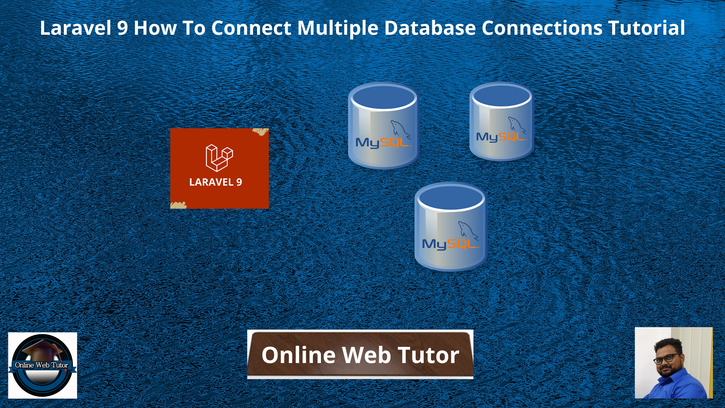In large scope projects, we use multiple data sources to control the flow of data and to manage it. Here, inside this article we will see the concept of Laravel 9 How To Connect Multiple Database Connections.
There are very few steps which is very very easy to do and connect with multi databases and perform operations. This is going to be very interesting article to learn and see the things. After this article two things will be totally clear out.
- Multiple databases
- Multiple connection groups
Article contains classified information about the concept of multiple databases. We will cover the entire concept so that you can learn about the complete steps in a very precised way.
Learn More –
- Laravel 9 Database Seeding from JSON File Tutorial
- Laravel 9 FullCalendar Ajax CRUD Tutorial Example
- Laravel 9 Generate PDF and Attach To GMail Email Tutorial
- Laravel 9 Google reCaptcha v3 Tutorial with Validation
Let’s get started.
Laravel Installation
Open terminal and run this command to create a laravel project.
composer create-project laravel/laravel myblogIt will create a project folder with name myblog inside your local system.
To start the development server of laravel –
php artisan serveURL: http://127.0.0.1:8000
Assuming laravel already installed inside your system.
Update .env File
The very first step to create secondary databases. To create secondary database environment variables we will use .env.
Open .env file and add details of other database as well.
//... DB_CONNECTION=mysql DB_HOST=127.0.0.1 DB_PORT=3306 DB_DATABASE=database_1 DB_USERNAME=root DB_PASSWORD=root //... DB_CONNECTION_2=mysql DB_HOST_2=127.0.0.1 DB_PORT_2=3306 DB_DATABASE_2=database_2 DB_USERNAME_2=root DB_PASSWORD_2=root //...
Here, database_1 and database_2 are two databases we have connected inside .env file.
Update Database File
Open database.php file from /config folder. This file contains the information of connection groups. Now, we need to use .env variables (secondary database) into it.
<?php
use Illuminate\Support\Str;
return [
'default' => env('DB_CONNECTION', 'mysql'),
'connections' => [
//...
// Primary database
'mysql' => [
'driver' => 'mysql',
'url' => env('DATABASE_URL'),
'host' => env('DB_HOST', '127.0.0.1'),
'port' => env('DB_PORT', '3306'),
'database' => env('DB_DATABASE', 'forge'),
'username' => env('DB_USERNAME', 'forge'),
'password' => env('DB_PASSWORD', ''),
'unix_socket' => env('DB_SOCKET', ''),
'charset' => 'utf8mb4',
'collation' => 'utf8mb4_unicode_ci',
'prefix' => '',
'prefix_indexes' => true,
'strict' => true,
'engine' => null,
'options' => extension_loaded('pdo_mysql') ? array_filter([
PDO::MYSQL_ATTR_SSL_CA => env('MYSQL_ATTR_SSL_CA'),
]) : [],
],
// Secondary database
'mysql_2' => [
'driver' => 'mysql',
'url' => env('DATABASE_URL'),
'host' => env('DB_HOST_2', '127.0.0.1'),
'port' => env('DB_PORT_2', '3306'),
'database' => env('DB_DATABASE_2', 'forge'),
'username' => env('DB_USERNAME_2', 'forge'),
'password' => env('DB_PASSWORD_2', ''),
'unix_socket' => env('DB_SOCKET', ''),
'charset' => 'utf8mb4',
'collation' => 'utf8mb4_unicode_ci',
'prefix' => '',
'prefix_indexes' => true,
'strict' => true,
'engine' => null,
'options' => extension_loaded('pdo_mysql') ? array_filter([
PDO::MYSQL_ATTR_SSL_CA => env('MYSQL_ATTR_SSL_CA'),
]) : [],
],
//...
],
//...
];Database Connections in Migration
When we create a migration file from artisan command, it stores inside /database/migrations folder and connected with primary database..
To connect with multiple database to migrations, look here these examples.
Primary Database(Default)
<?php
//...
public function up()
{
Schema::create('products', function (Blueprint $table) {
$table->increments('id');
$table->string('title');
$table->string('description')->nullable();
$table->timestamps();
});
}
//...Secondary Database
To connect migration with second database, use only Schema::connection(‘mysql_2’). Use connection method and connection name in both up() and down() methods.
<?php
//...
public function up()
{
Schema::connection('mysql_2')->create('products', function (Blueprint $table) {
$table->increments('id');
$table->string('title');
$table->string('description')->nullable();
$table->timestamps();
});
}
//...This is all about connecting migrations with multiple databases groups.
Database Connections in Model
When we create models using artisan command, it will be stored inside /app/Models and by default it will be connected to primary database.
To connect with multiple databases, look these examples.
Primary Database(Default)
<?php
namespace App;
use Illuminate\Database\Eloquent\Model;
class Product extends Model {
//...
}
Secondary Database
To use secondary database in model, use $connection protected variable in Model class.
<?php
namespace App;
use Illuminate\Database\Eloquent\Model;
class Product extends Model{
protected $connection = 'mysql_2';
}
This is all about connecting models with multiple databases groups.
Database Connections in Controller
If suppose, sometimes we want to connect database at runtime then we can connect direct from controller.
Primary Database(Default)
<?php
//...
class ProductController extends BaseController
{
public function getProducts()
{
$productModel = new Product;
$find = $productModel->find(1);
return $find;
}
}
Secondary Database
To connect with secondary database we use setConnection() method by model object and set connect group into it.
<?php
//...
class ProductController extends BaseController
{
public function getProducts()
{
$productModel = new Product;
$productModel->setConnection('mysql_2');
$find = $productModel->find(1);
return $find;
}
}This is all about connecting controllers with multiple databases groups.
Database Connections in Query Builder
We will see connection of query builder with primary and secondary database.
Primary Database(Default)
//...
$products = DB::table("products")->get();
print_r($products);
//...
Secondary Database
//...
$products = DB::connection('mysql_2')->table("products")->get();
print_r($products);
//...
We hope this article helped you to learn about Laravel 9 How To Connect Multiple Database Connections Tutorial in a very detailed way.
If you liked this article, then please subscribe to our YouTube Channel for PHP & it’s framework, WordPress, Node Js video tutorials. You can also find us on Twitter and Facebook.
Read more